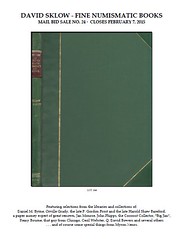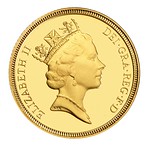
About UsThe Numismatic Bibliomania Society is a non-profit organization devoted to the study and enjoyment of numismatic literature. For more information please see our web site at coinbooks.org SubscriptionsThose wishing to become new E-Sylum subscribers (or wishing to Unsubscribe) can go to the following web page link MembershipThere is a membership application available on the web site Membership Application To join, print the application and return it with your check to the address printed on the application. Membership is only $20 to addresses in the U.S., $25 for First Class mail, and $30 elsewhere. For those without web access, write to: David M. Sundman, Treasurer
AsylumFor Asylum mailing address changes and other membership questions, contact David at this email address: dsundman@LittletonCoin.com SubmissionsTo submit items for publication in The E-Sylum, just Reply to this message, or write to the Editor at this address: whomren@gmail.com BUY THE BOOK BEFORE THE COIN |
- WAYNE'S WORDS: THE E-SYLUM DECEMBER 28, 2014
- PHOTOGRAPH OF JOSEPH B. FELT IN KOLBE & FANNING SALE
- CATALOGS AVAILABLE FOR SKLOW AUCTION #24
- NEW BOOK: THE 1838-O HALF DOLLAR
- BOOK REVIEW: MORGAN DOLLAR
- BOOK REVIEW: OPERATION MIDAS
- BOOK REVIEW: RHODE ISLAND COLONIAL MONEY
- BERT COHEN, MARBLE COLLECTOR
- CONGRESS PASSES NEW LAW ON FAKE COINS
- NOTES FROM E-SYLUM READERS: DECEMBER 28, 2014
- HOT AIR BALLOONS ON TOKENS
- THE TOKENS OF MADAME TUSSAUD'S EXHIBITION
- SELECTIONS FROM THE KOLBE & FANNING 2015 NEW YORK AUCTION
- THE PARTRICK 1792 CHALLENGE
- ON SIDEROGRAPHIC BANK NOTE PRINTING
- QUERY: WHERE DID THE U.S. MINT GET ALUMINUM?
- NUMISMATICS AND CRYPTOGRAPHY
- CHINESE FORGERS TARGET BIMETALLIC COINS
- GERMANS KEEP BILLIONS IN DEUTSCHMARKS
- CHINESE COUNTERFEITERS COULD ATTACK THE TWO POUND COIN
- U.S. RECYCLES OVER 90% OF DISCARDED BANKNOTES
- MCFADDEN COLLECTION OF PHILIPPINE EXONUMIA
- HOW BIG CAN NUMISMATIC ITEMS BE?
- THE OHIO BOOK STORE
- METAL DETECTING AND THE PORTABLE ANTIQUITIES SCHEME
- MORE TABLETOP PENNY ART
- CHRISTMAS LIGHT BONUS: CHINESE BANKNOTES
- FEATURED WEB PAGE: THE E-SYLUM ARCHIVE
Click here to access the complete archive
To comment or submit articles, reply to whomren@gmail.com
WAYNE'S WORDS: THE E-SYLUM DECEMBER 28, 2014

Your Editor is on the road, and we're publishing a little early tonight. We have no new subscribers this slow holiday week. Our total remains at 1,801 email subscribers.
This week we open with notes from literature dealers David Fanning and David Sklow, one new book and three reviews. Other topics include counterfeiting in colonial Rhode Island, Chinese forgers, a new law on fake coins, Madame Tussaud's tokens, and tabletop penny art.
To learn more about Joseph B. Felt, Bert Cohen, Mary Peck Butterworth, Nellie Tayloe Ross, Joan Murray (nee Clarke), the 1838-O Half Dollar, "Operation Midas", "forensicators" and the first known appearance of the dollar sign in print, read on. Have a great week, everyone!
Wayne Homren
Editor, The E-Sylum
PHOTOGRAPH OF JOSEPH B. FELT IN KOLBE & FANNING SALE

A highly important lot in Kolbe & Fanning’s upcoming New York Book Auction on January 10 is lot 285, a virtually complete set of both the Massachusetts Historical Society’s Collections and Proceedings. These volumes, absolutely essential for any research involving the early history of New England, include important early U.S. numismatic publications, most notably the foundational articles by James Mease and J. Francis Fisher found in the third series of the Collections. However, little-known numismatic nuggets await discovery throughout the 178 volumes present for both series.
One such “nugget” is this photograph, taken in May 1855, of members of the Massachusetts Historical Society. Published in Volume II of the Proceedings of the Massachusetts Historical Society (published 1880, covering 1835-55), the photo depicts a number of prominent historians and scholars of the period. Included among their number is Joseph B. Felt, author of An Historical Account of Massachusetts Currency (1839). Based on two lectures given before the MHS, this enduring history of Massachusetts coins and currency is one of the first major works, and certainly the most important early effort, to comprehensively cover an American numismatic topic.
Felt is seated second from the left (from our perspective) in the photograph, which is the only photo of Felt either George Kolbe or David Fanning recall seeing. The MHS Proceedings volume identifies everyone in the photo as follows:
Seated in center: James Savage
Moving from Savage to the left: Josiah Quincy, Jared Sparks, John C. Gray, Rev. William Jenks, Nathan Appleton, Rev. J.B. Felt, Charles Francis Adams.
Moving from Savage to the right: Lemuel Shaw, Edward Everett, William H. Prescott, Daniel A. White, David Sears, Abbott Lawrence, Rev. G.W. Blagden, George Ticknor.
Standing, left to right: Rev. Chandler Robbins, Charles Deane, Richard Frothingham, Nathaniel B. Shurtleff, Joseph Willard, Rev. W.P. Lunt, Rev. S.K. Lothrop, Rev. Geo. E. Ellis, George S. Hillard, and Robert C. Winthrop.
The Proceedings record notes that as the number of resident members was at that time limited to sixty, nearly half of them were included in this photograph.
Kolbe & Fanning’s public auction will be held on Saturday, January 10, 2015 at the Waldorf-Astoria Hotel in New York City. The sale will be held in conjunction with the New York International Numismatic Convention. Printed catalogues have been mailed to established clients. A PDF of the catalogue has been posted to the Kolbe & Fanning website at www.numislit.com. Prospective bidders may also access the live online catalogue and register to bid through auction.numislit.com. Please contact David Fanning at df@numislit.com for more information.
CATALOGS AVAILABLE FOR SKLOW AUCTION #24
Catalogs for Numismatic Literature Auction Sale # 24 Closing February 7, 2015 are now being shipped. The catalog is also available for viewing and downloading on our web site.
Sale contains almost something for everyone, within its over 1000 lots! Of special interest, the wonderful collection of works concerning Medals, Awards & Decorations from the Dan Byrne Library; A group of the famous Counterfeit Detectors by Laban Heath; Mint Director Reports; Nice early Numismatists; A complete set of the Numismatic Scrapbook; Great Canadian Periodicals; Early Auction Catalogs; Treasure & Shipwreck literature; Many works on tokens; A 1900 De Knight on History of the Currency [featured on the front cover]; Wonderful autographed items [one featured on the back cover]; Many deluxe G. F. Kolbe Catalogs;
Bid via Mail, Phone, Email and Fax; There have been no changes to our terms of sale;
Enjoy our catalog!
David
David Sklow-Fine Numismatic Books
P.O. Box 6321
Colorado Springs, CO 80934
PH: 719-302-5686
FAX: 719-302-4933
Email: numismaticbooks@aol.com
Web Site: FineNumismaticBooks.com
NEW BOOK: THE 1838-O HALF DOLLAR
The 1838-O Half Dollar, An Alignment of the Stars, by Kevin Flynn and John Dannreuther will be going to the printers in the beginning of January and should be ready at end of January. This book is being self-published, with only a limited number being printed. The book is 8 ½ by 11, approximately 90 pages. Softcover $29.95 plus shipping.
The primary purpose of this book was to do a complete analysis of the 1838-O half dollar. It start out as a simple question as to whether some coins were struck in Philadelphia and ended up uncovering most of the history of this variety.
The evidence absolutely shows that all of the 1838-O half dollars were struck at the New Orleans Mint. No specimen was struck by the Philadelphia Mint before the dies were shipped to the New Orleans Mint in April, 1838. There were also two strikings in New Orleans, one in late January, and a second in late March 1839. We show which coins were struck during each striking. The archive records found and presented show why most of these coins were struck, who struck them. Many of these records have not before been published. The diagnostics of the coins was also used to determine other key elements such as the order the coins were struck and also helped determine a second striking was made in late March.
A detailed photograph comparison was done between the 1838-O Smithsonian specimen, that is the key to these discoveries, and the 1838 proof at the Smithsonian, and other 1838-O half dollars is provided. There are die cracks on the 1838-O Smithsonian specimen that do not exist on any other 1838-O half dollar. Also presented is an analysis of the 1839-O half dollars that have been called proofs that is also an integral part of the 1838-O half dollars.
All theories are presented with an analysis of each. All facts, conclusion, untrue, and a summary are given. A historical timeline and detailed analysis of the die making process will help understand some of the dependencies.
Our analysis of the 1838-O half dollars, besides the Smithsonian specimen was primarily through photographs and digital images, same was for the 1839-O half dollars called proofs. We are looking to study the other 1838-O half dollars to confirm the die states and surface texture. Please contact John or myself if you have a specimen.
Price for the softcover is $29.95. To order, send a check or money order to Kevin Flynn, P.O. Box 396, Lumberton, NJ 08048. Please include $5 for media shipping or $10 for first class shipping. Please email me at kevinjflynn88@yahoo.com to reserve a copy. See other books available at www.kevinjflynn.com .
THE BOOK BAZARRE
BOOK REVIEW: MORGAN DOLLAR
Dennis Tucker of Whitman Publishing writes:
I’m attaching a book review that Mike Nottelmann wrote for “Coin Talk Radio.” It’s for Miles Standish’s Morgan Dollar: America’s Love Affair With a Legendary Coin. Mike grants permission for his reviews to be published. I thought this might interest the readers of The E-Sylum.
 For years, the
Morgan Dollar has been a favorite of American coin collectors. Generation after generation have collected these large silver coins for varying
reasons. Many enjoy the history and imagery of the “Wild West” where some of these coins were used in circulation. Some have collected them because
of their worth above their face value, and yet others have been compelled by the availability of 100+ year old coins that still exist in pristine
condition.
For years, the
Morgan Dollar has been a favorite of American coin collectors. Generation after generation have collected these large silver coins for varying
reasons. Many enjoy the history and imagery of the “Wild West” where some of these coins were used in circulation. Some have collected them because
of their worth above their face value, and yet others have been compelled by the availability of 100+ year old coins that still exist in pristine
condition.
The release of the GSA hoards in the 1960s changed the world of Morgan Dollars and the availability of certain date and mintmark combinations to the public, and yet, even the release of thousands of coins thought to be lost forever didn’t quench the collecting world’s appetite for these large cartwheels.
While most series of American coinage will suffice with a single reference, it seems that Morgan Dollars have compelled more writers than any other. Q. David Bowers has written more than one covering this series, and yet our hunger to know more about Morgans continues to go unsatisfied.
Michael “Miles” Standish has recently released a new Morgan Dollar reference. One that I feel is worthy of your consideration and would be an excellent addition to your numismatic library. Morgan Dollar: America’s Love Affair With a Legendary Coin is a brilliant book that explores these legendary coins and features the Coronet Collection, ranked number 1 by PCGS as the finest Morgan Dollar set of all time, to illustrate examples of each coin by date and mintmark.
Standish, Vice President and Senior Grader at PCGS describes the rich history of America during the Morgan Dollar Era, and faithfully describes the symbolism utilized in the obverse and reverse designs. He also breaks the series down for his readers year by year and Mint by Mint.
Included are certified populations, and retail prices in multiple grades. He describes general strike characteristics and rarity for each coin as well. Also included is an entire chapter devoted to the proof coinage date by date describing the strikes one will encounter in surviving examples from each year.
Standish has endeavored to bring readers the finest reference on Morgan Dollars available today. His concise writing style is easy to read and packed with useful information. His historical accounts and use of current population data illuminate the romance and wide appeal of these coins, making sense of the rarity and desirability of each issue.
Unlike many other Morgan references, illustrations are a true highlight of this book, utilizing absolutely stunning photography of the Coronet Collection. Collectors can see with their own eyes what should be strived for in each and every coin.
In my opinion, Standish has hit the nail squarely on the head with this book. He has re-defined the Morgan Dollar reference and created what is to date, the ultimate volume on this series. A book that will be valued by Morgan Dollar enthusiasts at all levels of interest. A treat for both your eyes and your mind that will be studied and enjoyed for years to come.
Available from Whitman publishing for $29.95 US, Morgan Dollar: America’s Love Affair With a Legendary Coin is tuition for your numismatic education that is well worth the investment.
To read the complete article, see:
Morgan Dollar: America’s Love Affair With a Legendary Coin by Michael “Miles” Standish
(www.coinshowradio.com/archives/777)
BOOK REVIEW: OPERATION MIDAS
Herb Friedman writes:
I did read Operation Midas and sent a review to Amazon. I have reviewed numerous books there and they were all accepted. They turned this one down. I don't blame them. The book is a total rip-off.
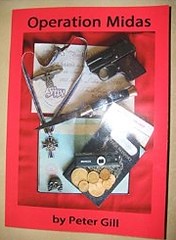 I cannot call this a book because in reality it is more like a pamphlet. One
would think that it is a well-documented report on a Nazi plot to counterfeit gold. In reality, we find none of that. The author meets some female
one day, gets to drinking with her and somehow end up with a gold coin she wore. Later he gets more. He throws in some real Historical names like
"Operation Bernhard" and "SS Major Bernhard Kruger" to make the story seem real, but he never gives any specifics about this
alleged Nazi plot to counterfeit gold coins. On several occasion he mentions "alchemy" which should have been warning enough.
I cannot call this a book because in reality it is more like a pamphlet. One
would think that it is a well-documented report on a Nazi plot to counterfeit gold. In reality, we find none of that. The author meets some female
one day, gets to drinking with her and somehow end up with a gold coin she wore. Later he gets more. He throws in some real Historical names like
"Operation Bernhard" and "SS Major Bernhard Kruger" to make the story seem real, but he never gives any specifics about this
alleged Nazi plot to counterfeit gold coins. On several occasion he mentions "alchemy" which should have been warning enough.
I kept expecting the booklet to get real and waited to hear about where the coins were minted, who distributed them, what the law has to say; but it was more like a discussion of Area 51. It goes nowhere. This is probably the first time I really felt ripped off by a Kindle book. It is a complete mess with no redeeming factors. The best thing about this entire book is the cover which shows a pistol and some gold coins. Curiously, about 40 years ago I wrote an article about propaganda postcards of WWII and used a similar cover depicting my own military .45. Once you get past the cover there is nothing of interest.
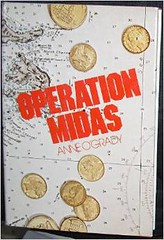
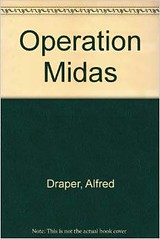
Herb adds:
The problem is that I really wanted the story to be true. I have a dozen books on Operation Bernhard and have even mentioned it just a bit in one of my articles on German propaganda currency of WWII. Hell, after WWII I had a correspondence with Bernhard. This would have been so interesting; a brand new plot that went alongside the paper money counterfeits.
To read the earlier E-Sylum article, see:
NEW BOOK: OPERATION MIDAS (www.coinbooks.org/esylum_v17n52a07.html)
To order the book on Amazon, see:
www.amazon.com/Operation-Midas-Peter-Gill-ebook/dp/B00PM98FJW/
BOOK REVIEW: RHODE ISLAND COLONIAL MONEY
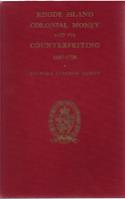 Take it from the Numismatic Bookie: if you collect numismatic literature, you’ll never run short of fascinating facts about your hobby.
Take it from the Numismatic Bookie: if you collect numismatic literature, you’ll never run short of fascinating facts about your hobby.
After 35 years of serious searching, I still regularly encounter new (at least to me) books packed with remarkably interesting information.
Did you know that one of Colonial America’s most notorious counterfeiters was a woman? I didn’t until August 2014, when I snared an obscure volume at a benefit auction for the Numismatic Bibliomania Society.
Each year at the NBS annual meeting, generous club members like Dan Hamelberg and David Sundman donate books for a fundraising auction to help cover NBS operating expenses. Having a particular weakness for information about numismatic rogues and rascals, I knocked down Richard LeBaron Bowen’s 1942 book, Rhode Island Colonial Money and its Counterfeiting.
Bowen’s tales all fascinate, but none more so than that of Mary Peck Butterworth, daughter of a prominent family and wife of a successful carpenter, who thus had no need to “carry boodle” in order to survive.
Mary, however, was a shrewd and innovative businesswoman, who enjoyed beating the old boys at their own games.
It all began in 1716. Mary watched her competitors make two mistakes time and again: they printed their bills from copper plates, which were difficult to engrave well enough to make convincing counterfeits; and, when the constable searched their premises, he inevitably found the copper plate, which became evidence.
So she applied her considerable Yankee ingenuity to solve both problems through kitchen chemistry.
Mary took a new genuine Rhode Island bill, laid it flat on her table, covered it with a piece of starched muslin, and ironed both, which transferred some printing from the new bill to the muslin. She then laid a blank piece of paper on the table, covered it with the imprinted piece of muslin, and ironed both vigorously. Ink transferred from the muslin to the blank paper, rendering a close copy of the original bill. A few blanks and weak spots were filled with ink with a quill pen.
Finally, when her muslin “plate” gave out, Mary destroyed the incriminating evidence by dropping it into her kitchen fire.
From 1716 to 1723, Mary made an ever-increasing number of fake Rhode Island bills.
Eventually she employed several individuals to “pass the queer bills.”
But in 1723, all that activity attracted police attention, and Mary, her husband, and several of her employees were arrested on suspicion of counterfeiting.
None did time, for thanks to Mary’s innovative rascality, the evidence required to convict them had literally gone up in smoke.
To read the complete article, see:
Treasures abound in the story of
a very innovative female counterfeiter in the 1700s
(www.coinworld.com/insights/Treasures-abound-in-the-story-of-an-innovative-female-counterfeiter.html)

BERT COHEN, MARBLE COLLECTOR
Bert Cohen does indeed have all his marbles, some 300,000. His first was a German-made sulphite with the image of a rooster, given to him 45 years ago by an antiques dealer who told him that collecting marbles was a way to have fun with his children. He discovered that marbles aren't just for games children play.
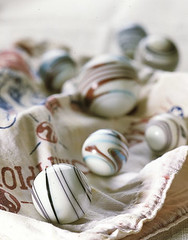 The
oldest and rarest varieties date to ancient Egypt. Today, the most sought-after collectibles include marbles handmade in Germany from 1850 to 1920,
when production of machine-made marbles began. Whether handcrafted or factory made, "People love to look at them, fell them, hold them,"
says Cohen, a retired toy manufacturer.
The
oldest and rarest varieties date to ancient Egypt. Today, the most sought-after collectibles include marbles handmade in Germany from 1850 to 1920,
when production of machine-made marbles began. Whether handcrafted or factory made, "People love to look at them, fell them, hold them,"
says Cohen, a retired toy manufacturer.
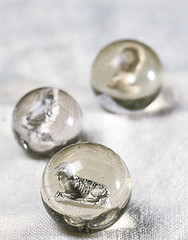 "They're beautiful because of their color, shape, and size, which ranges in diameter from under an inch to three inches. Known as sulphites,
these intriguing glass spheres contain embedded object such as animals.
"They're beautiful because of their color, shape, and size, which ranges in diameter from under an inch to three inches. Known as sulphites,
these intriguing glass spheres contain embedded object such as animals.
 Onionskin marbles are so called because their characteristic swirls of colored
glass make them appear to have many layers. Handmade marbles start at $10 each. Rare antique marbles can run over $1,000 apiece.
Onionskin marbles are so called because their characteristic swirls of colored
glass make them appear to have many layers. Handmade marbles start at $10 each. Rare antique marbles can run over $1,000 apiece.
To read the complete article, see:
Marble Collector Bert Cohen
(www.countryliving.com/antiques/what-to-collect/marble-collector-0506#slide-1)
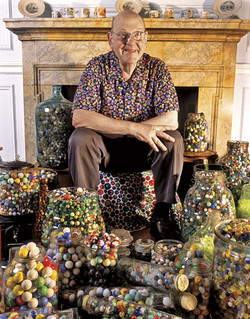 It
is with great sadness we report that Bert Cohen passed away suddenly, at the age of 83, on December 21, 2014. His passing is a huge loss to marble
collectors all around the world.
It
is with great sadness we report that Bert Cohen passed away suddenly, at the age of 83, on December 21, 2014. His passing is a huge loss to marble
collectors all around the world.
Bert was known throughout the marble community as “MarbleBert”. He was one of the pioneers of marble collecting. For over 40 years he has been a tireless booster of marble collecting and marble playing. Numerous contemporary marble artists have been encouraged and supported early in their careers by Bert.
Many marble collectors don’t know that Bert has a family connection to toys. He is from the Leominster, Massachusetts area, and his father-in-law (Nina’s father) was the owner of the Irwin Toy Company. Bert worked at the Irwin factory in its heyday, back when they made the first Barbie car. He later served as its President.
Bert's marble collection has been showcased in Smithsonian Magazine, House & Garden, Art & Antiques and The Flow magazines. He has made appearances on Chronicle, CNN and MTV Europe, and has spoken for such prestigious institutes as The Jones Museum and The Museum of our National Heritage, just to name a few.
Bert was quoted once as saying. "I like anything dealing with marbles...they are beautiful! When I look at a marble I am attracted to the color, the shape and the size and am amazed at the ability of the artist to transform glass in so many ways, creating a world of wonder."
In addition to marble collecting, Bert was a supporter of marble playing. He sponsored marble tournaments on Boston Common, as well as involvement with the US National Marbles Tournament and the annual Good Friday tournament at Tinsley Green in England.
Bert was also the manager and promoter of the Northeast Marble Meet for the past thirty years. Just this past October, he was honored at the Marble Meet in Marlborough MA for his long years of service to the marble collecting community.
To read the complete article, see:
OBITUARY - BERT COHEN
(http://us6.campaign-archive2.com/?u=15c919030500156f88bac9e74&id=390b8837d3&e=6150f94915)

CONGRESS PASSES NEW LAW ON FAKE COINS
Fake antique gold and silver US coins – many purporting to be more than 200 years old — are flooding the US resale market from China, and Congress just passed a law to do something about it.
The legislation breezed through the Senate in the final days of the session, and was one of the last bills President Obama signed into law before jetting to Hawaii.
With the market for rare and antique coins booming – and the biggest coin markets in New York — forgers have mastered the art of creating nearly exact replicas of valuable collectors’ items, with enough precision to fool the experts.
Sometimes forgers manufacture the fakes out of real gold or silver. Other times they insert less precious materials like titanium inside the coin, but manage to duplicate the exact weight of precious metals.
“They’re very deceptive,” said former Rep. Jimmy Hayes (R-La.), a lobbyist who helped push through the bill. “I assure you there’s no way to tell if it’s good or not. You’ll never suspect.”
Hayes said a typical Chinese forger might spend $30 making a fake rare coin that can go for $1,200.
Hayes knows something about the value of real antique coins. He sold his own childhood coin collection for $1.2 million to finance a run for Congress in the 1990. He says now it would be worth about $60 million.
The new law makes it illegal to sell imitation coins unless they are clearly marked as a “copy.” It makes it a crime to aid the manufacturer, importer, or seller of forged items.
And if special collection certificates get faked as part of a scheme, the owner of the trademarks on the certificates are entitled to seek damages.
Individuals can file civil lawsuits against sellers of fake coins, buttons, and posters to try to recoup costs.
The fraudsters are taking a toll on pawn shops. The average mom-and-pop dealer loses $3,500-$4,500 when the fall for fake coins, said Doug Davis, a longtime police officer who runs the Numismatic Crime Information Center.
A group called the Gold and Silver PAC spent some coin of its own to help get its priority bill across the finish line. The PAC made $72,000 in campaign contributions in 2013 and 2014, according to the Center for Responsive Politics web site.
Recipients from the last two election cycles included sponsor G.K. Butterfield (D-N.C.), who got $5,000, Sen. Ed Markey (D-Mass.), who got $10,000, Rep. Steve Scalise (R-La.), who got $7,000, and Rep. Henry Waxman (D-Calif.) got $5,000.
According to the PAC’s web site: “After the bill had been stalled in the Senate for over a year, Legislative Consultant Jimmy Hayes and Gold & Silver PAC Chairman Barry Stuppler met Barry’s Congressman, Henry Waxman (D-CA) to ask Rep. Waxman to help get this bill moving in the Senate.”
“With Waxman’s efforts combined with our friends in the Senate on the Commerce Committee did the trick. Two months later the bill was passed without any opposition.”
To read the complete article, see:
Congress passes law to curb manufacturing of fake
coins (http://nypost.com/2014/12/25/congress-passes-law-to-curb-manufacturing-of-fake-coins/)
NOTES FROM E-SYLUM READERS: DECEMBER 28, 2014
Mint Director Nellie Tayloe Ross
Bruce W. Smith writes:
I found a book which some E-Sylum readers will be interested in -- a biography of Mint Director Nellie Tayloe Ross. Title is: Governor Lady: The Life and Times of Nellie Tayloe Ross. Author Teva J. Scheer, published by University of Missouri 2005, hardcover 312 pages (ISBN 0826216269). The book is available from Amazon new for $25 or used for under $10.
Ross was elected governor of Wyoming in 1924 -- only 5 years after women gained the right to vote. In 1928 she was vice chairman of the Democratic National Committee and was nominated for vice president the same year. In 1932 she was appointed the first woman director of the U.S. mint. Oddly, she ran for governor only because her husband, who was governor, died and left her with four children and no income. She died in 1977 at the age of 101.
William McChesney Martin of St. Louis Fed
Bruce W. Smith writes:
Awhile back someone asked either on The E-Sylum or in Bank Note Reporter for biographical information on William McChesney Martin, the first Chairman of the St. Louis Federal Reserve Bank. Martin (1874-1955) was born in Lexington, Kentucky. In 1900 he graduated from Washington University (St. Louis) law school and immediately joined the Mississippi Valley Trust Company of St. Louis. He joined the Federal Reserve Bank in 1914 and his signature can be found on the early notes of the St. Louis branch.
Biographical information about him can be found in Who's Who in the Midwest (1949) page 809; Who's Who in St. Louis (1928) page 71; and Book of St. Louisans (1912 edition) page 397. He is mentioned briefly in: Banking in Mid-America: A History of Missouri's Banks, by Timothy W. Hubbard and Lewis E. Davids (1969), the standard work on Missouri banking history.
First Appearance of Machin's Elizabeth II Portrait
 Regarding The second effigy of Queen Elizabeth II by Arnold Machin (1968-1984), the
article quoted last week said:
Regarding The second effigy of Queen Elizabeth II by Arnold Machin (1968-1984), the
article quoted last week said:
His design made its first appearance in 1968 on the 5p and 10p coins, the first of the ‘new’ coins that were able to circulate alongside the ‘old’ coins due to the equivalent pre-decimal values of the shilling and florin.
I know the above refers specifically to UK coinage, but technically his design appeared earlier than that in Canada (1965) & Australia (1966), and probably elsewhere, but I don't have my catalogs with me to confirm this.
I'm betting I'm not the first to point out that this is a repeat of the Machin portrait & not the Maklouf!
To read the earlier E-Sylum article, see:
THE EVOLVING EFFIGY OF QUEEN ELIZABETH (www.coinbooks.org/esylum_v17n52a23.html)
The Relative Weights of Gold and Lead
 Last
week's article about Hanukkah Gelt (chocolate coins) stated that "Gold is almost three times as heavy as lead by volume". Rich Hartzog
writes:
Last
week's article about Hanukkah Gelt (chocolate coins) stated that "Gold is almost three times as heavy as lead by volume". Rich Hartzog
writes:
Well, according to: www.aqua-calc.com/calculate/volume-to-weight a cubic meter of gold would weigh 19,320kg, the same lead would weigh 11,342kg. Closer to 1.5 times as heavy as lead, not 3x.
To read the earlier E-Sylum article, see: IF HANUKKAH GELT WERE REAL GOLD (www.coinbooks.org/esylum_v17n52a33.html)
THE BOOK BAZARRE
HOT AIR BALLOONS ON TOKENS

Last week we published Joel Orosz's article on famous numismatists who rode in balloons. David Powell writes:
Not so much ballooning numismatists, but rather balloons as the subject matter on numismatic items: please see my article "Going Down like a Lead Balloon - well, here is one" in edition 98 of my lead token newsletter:
Going Down like a Lead Balloon - well, here is one
Well, here is a first; a hot air balloon on a lead token. Fig.1 is 4.32gm in weight and 22mm across, yet from its subject matter it cannot presumably be earlier than the Montgolfier experiments of 1783. The English Channel was crossed in 1785, and presumably knowledge of the feat, and interest in the subject, spread in Britain, to urban centres at least, fairly quickly. This is a Thames find; quite likely it is a ticket for a close-up view of an ascent, probably in the Greater London area, very much along the lines of the ticket for a public hanging shown on page 4 of LTT_60.
The only other token issuer I can think of who depicted a balloon is the flamboyant businessman Isaac Earlysman Sparrow {b. Deptford 1793, d. London 1830}, who issued a number of fairly common advertising pieces, commonly construed as unofficial farthing tokens, in the mid-1820s {Fig.2}. Sparrow, an ironmonger who in 1826 also produced a leather sauce, presumably some kind of polish or preservative, was obsessed with balloons; on 23 June 1823 he went up in one with Charles Green, a famous 19th century aeronaut, and boasted about it ever after. All known varieties of his tokens depict a balloon, and his premises in Bishopsgate were shortly afterwards named Balloon House.
Sparrow was twice afflicted by bankruptcy during his last few years and one must wonder to what extent his ballooning interests were responsible for that. Could he, or would he, have issued lead tokens, either before his copper ones, or after his financial difficulties, when he was less affluent? His copper pieces are all around 23mm, only a millimetre or so larger than Fig.1, which might also have passed for a farthing; but the characters on the back of the lead piece are indistinct, and if initials contain nothing which might pass as an I or an S.
To read the complete issue, see:
Leaden Tokens Telegraph July/Aug 2014
(www.mernick.org.uk/leadtokens/newsletters/LTT1407_98.pdf)
To read the earlier E-Sylum article, see:
BALLOONING NUMISMATISTS (www.coinbooks.org/esylum_v17n52a15.html)
THE TOKENS OF MADAME TUSSAUD'S EXHIBITION
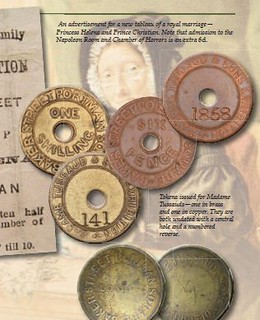 From an early age Marie Grosholtz had been taught the art of wax modelling by her uncle, Philippe
Curtius. Marie had a natural ability and soon became an expert in the art, working her uncle’s exhibition in Paris. Later she was appointed art tutor
to Louis XVI’s sister and lived at Versailles for eight years. While in Paris Marie met and made casts of most of the personalities of the period,
both revolutionaries and royalists. During the Revolution she had to make death masks of several victims of the guillotine including King Louis XVI
and his Queen, Marie Antoinette. When her uncle died in 1794, Marie being his only heir took over the exhibition. The following year she married
Francois Tussaud with whom she had two sons.
From an early age Marie Grosholtz had been taught the art of wax modelling by her uncle, Philippe
Curtius. Marie had a natural ability and soon became an expert in the art, working her uncle’s exhibition in Paris. Later she was appointed art tutor
to Louis XVI’s sister and lived at Versailles for eight years. While in Paris Marie met and made casts of most of the personalities of the period,
both revolutionaries and royalists. During the Revolution she had to make death masks of several victims of the guillotine including King Louis XVI
and his Queen, Marie Antoinette. When her uncle died in 1794, Marie being his only heir took over the exhibition. The following year she married
Francois Tussaud with whom she had two sons.
1802 Marie decided to take her models to London and set up a display at the Lyceum in the Strand. The following year she took the exhibition to Edinburgh and two years later she was in Ireland. Marie and Joseph, her elder son, spent the next 30 years touring the country setting up the displays for a few days or several months depending on how many people paid to see the exhibitions. It was during these travels that Marie’s other son, Francis, came to join his brother and mother. The three of them returned to London in 1832 and three years later settled permanently at the Bazaar on the corner of Baker Street and Portman Square.
Over the years there had been many waxwork displays in London so Marie had to make sure that hers had something special that would attract the visitors. She had learnt from Curtius that having models of some the personalities of the day was always popular, so along with the various tableaus of the royal family and George IV’s coronation there were models of politicians, actors and opera singers—and a corner was set aside for the latest villains.
Marie had always been fascinated by Napoleon, having met him when he was First Consul and again on his way to St Helena. During the early 1840s many Napoleonic items were purchased including his travelling coach which had been at the Egyptian Hall. In 1843 two new rooms devoted to Napoleon were opened and were a great success, attracting many visitors.
As the number of criminals on display increased, a separate room was set aside for them; it was the magazine, Punch, that coined the phrase “chamber of horrors” when they used it as a term of derision in describing one of the displays, but it had the opposite effect and drew even more visitors.
Advertisements of the time show that the price of admission for adults was one shilling and sixpence for children and it seems likely that the metal tickets were issued around this time as their values correspond with the prices of admission. The two tokens are very similar in design, but the shilling is usually found in brass while the sixpence is normally in copper. They are both undated with a central hole and all are numbered on the reverse.
The obverse has the value in the centre and around the edge reads BAKER STREET PORTMAN SQUARE, while in the centre of the reverse is the number and around the edge MADAME TUSSAUD & SONS EXHIBITION. There is a third brass token on which the legend around the edge of the obverse and reverse are the same as the previous ones, but in the centre of the obverse it reads LONDON while the centre of the reverse is blank. This piece was possibly used to gain admission to the Napoleon rooms as an extra sixpence was charged to see them, otherwise its purpose is unclear and, as usual, no references have been found to the use of these tokens.
A portrait of Marie, showing her still working, was painted when she was 84. By this time she had taken her sons, Joseph and Francis, into partnership and when she died in 1850, they took over the business. It was they who in 1884 moved the exhibition to its present site in Marylebone Road in new purpose-built premises. A card ticket giving entrance to the exhibition is signed by John Tussaud, and may well have been given by him, it also allowed admittance to the extra rooms.
Madame Tussaud’s had become part of the establishment and was one of the places to visit when in London; that was until 1925 when fire destroyed nearly all the building and its contents. Rebuilding started straight away and the exhibition re-opened in 1928 with the addition of a cinema. Unfortunately this was destroyed in the war and some years later the Planetarium was opened instead. The last of Marie’s descendants who took an active part in the management of the company was her great grandson Bernard, who died in 1967.
For more information, or to subscribe to Coin News, see:
http://www.tokenpublishing.com/coins.asp
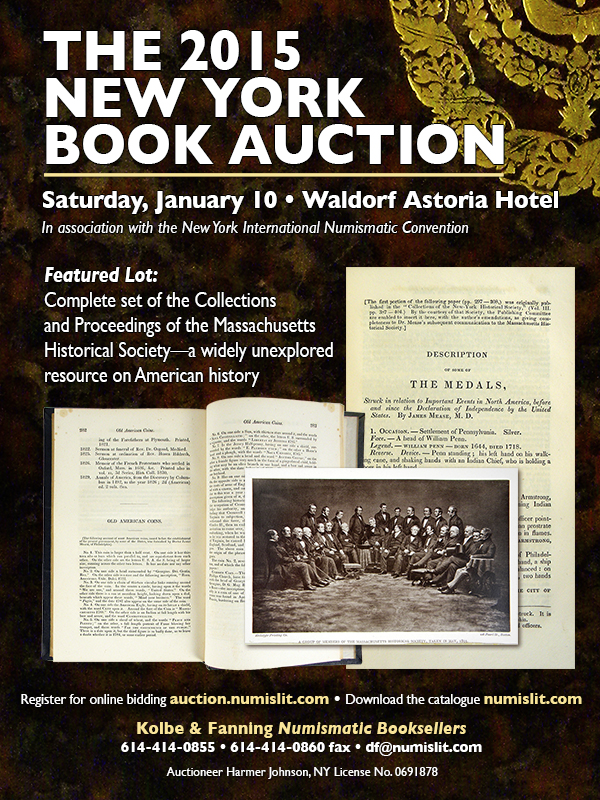
SELECTIONS FROM THE KOLBE & FANNING 2015 NEW YORK AUCTION
Brause-Mansfeld on Siege Money
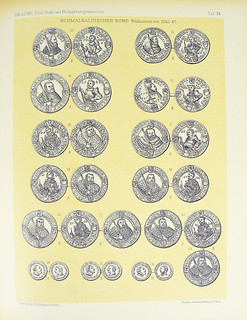 100 Brause-Mansfeld, August. FELD-, NOTH- UND BELAGERUNGS-MÜNZEN VON DEUTSCHLAND, ÖSTERREICH-UNGARN,
SIEBENBÜRGEN, MOLDAU, DÄNEMARK, SCHWEDEN, NORWEGEN, RUSSLAND, POLEN U.S.W. [with] FELD-, NOTH- UND BELAGERUNGSMÜNZEN VON ENGLAND, FRANKREICH,
HOLLAND, ITALIEN, SPANIEN. Berlin: Verlag von J. A. Stargardt, 1897 & 1903. Two volumes. Folio, slightly later matching green cloth, gilt. xi,
(1), 118; viii, 80, (2) pages; printed and attractively engraved titles in red and black; 48 + 7 + 38 handsome photolithographic and photogravure
plates of coins and currency bound in on hinges. Bindings a bit worn, with small tear to cloth at head; contents fine. (1000.00)
100 Brause-Mansfeld, August. FELD-, NOTH- UND BELAGERUNGS-MÜNZEN VON DEUTSCHLAND, ÖSTERREICH-UNGARN,
SIEBENBÜRGEN, MOLDAU, DÄNEMARK, SCHWEDEN, NORWEGEN, RUSSLAND, POLEN U.S.W. [with] FELD-, NOTH- UND BELAGERUNGSMÜNZEN VON ENGLAND, FRANKREICH,
HOLLAND, ITALIEN, SPANIEN. Berlin: Verlag von J. A. Stargardt, 1897 & 1903. Two volumes. Folio, slightly later matching green cloth, gilt. xi,
(1), 118; viii, 80, (2) pages; printed and attractively engraved titles in red and black; 48 + 7 + 38 handsome photolithographic and photogravure
plates of coins and currency bound in on hinges. Bindings a bit worn, with small tear to cloth at head; contents fine. (1000.00)
Ex Wayne Raymond, with his bookplate. A clean, fresh set of this great classic work on siege money, handsomely designed and printed. Rare and still indispensable. Clain-Stefanelli 16289*. Grierson 44. Mária & Lajos 227.
A Consequential Misspelling?
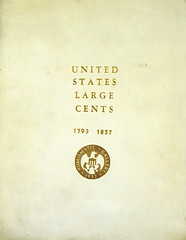
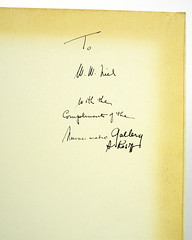
The Deluxe Leatherbound Edition. Inscribed in black ink on the front free flyleaf: “To W.W. Niel (sic) with the Compliments of the Numismatic Gallery, A. Kosoff.” An important catalogue, produced with the usual Kosoff flair. After listing 479 large cents of overall exceptionally fine quality and depicting both sides of 288 of them, Kosoff appended illustrated reprints of Crosby on 1793s and Chapman on 1794s. This famous catalogue is virtually unknown in the deluxe binding.
The only examples we recall ever having seen are Sol Kaplan’s, sold in our October 17, 1992 Mendelson Library sale, and Homer K. Downing’s, sold in our June 1, 2004 Ford Library sale. Suave and debonair, Abe Kosoff carefully cultivated his best clients, hoping ultimately one day to handle their collections. Some of his competitors and contemporaries, perhaps in envy, are known to have termed him “the widow’s friend.”
Will W. Neil’s outstanding collection of American coins was sold at auction three years after publication of the Pearl catalogue—not by Numismatic Gallery but by B. Max Mehl. In 1941, Kosoff had uncharacteristically misspelled his own name in an auction catalogue and, though it seems unlikely, one cannot help but wonder if this subsequent faux pas had consequences far more serious than the mere misplacement of a dot. Ex Kolbe Sale 111, lot 97. Ex Dave Steine library.
First Known Appearance of the Dollar Sign in Print, and Earliest Known Illustration of a U.S. Coin
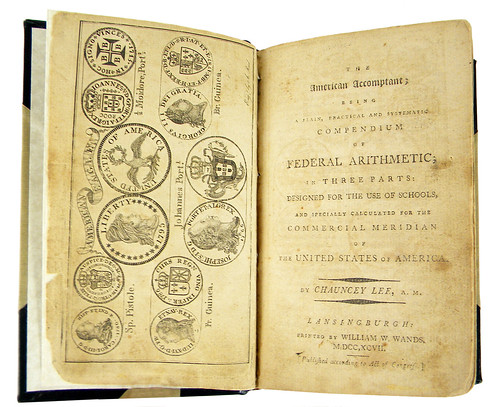
280 Lee, Chauncey. THE AMERICAN ACCOMPTANT; BEING A PLAIN, PRACTICAL AND SYSTEMATIC COMPENDIUM OF FEDERAL ARITHMETIC; IN THREE PARTS: DESIGNED FOR THE USE OF SCHOOLS, AND SPECIALLY CALCULATED FOR THE COMMERCIAL MERIDIAN OF THE UNITED STATES OF AMERICA. Lansingburgh: Printed by William W. Wands, 1797. 12mo, modern green half calf, gilt; spine with five raised bands, ruled, lettered and decorated in gilt; two red spine labels, gilt. Frontispiece engraving of coins in current usage in the U.S. by A. Reed; 297, (15) pages. Marginal wear to frontispiece, on the blank recto of which is an original ownership inscription. Moderate browning. Very good or better in an attractive recent binding. (1500.00)
This early American accounting and bookkeeping manual contains what is generally believed to be the first appearance in print of the dollar sign ($). It also includes, as a frontispiece, an engraving depicting a 1795 U.S. eagle, which Eric Newman has called “the earliest known illustration of a United States coin.”
Also included on the engraving are the Spanish pistole, French “guinea,” British guinea, and Portuguese Johannes and half moidore. The book consists of a series of practical lessons for clerks. The dollar sign, which appears on page 56 for the first time and then throughout the volume, is a typographical approximation based upon the handwritten dollar sign used by some during the period. It resembles our own, but also differs from it. Much as a typographical ampersand is much more stylized than most of our handwritten ampersands, this initial attempt at a dollar sign in type is less a strict representation of the handwritten sign than an attempt to establish a similar sign for more formal treatment in type.
A rare volume, of very high importance. For a fascinating overview of the history of the dollar sign, see Eric P. Newman’s “The Dollar $ign: Its Written and Printed Origin” in America’s Silver Dollars (New York: ANS, 1995). Evans 32366: “It is claimed that this work was the first to use the dollar mark, $.” Howes L196 (aa): “First book to adopt the dollar sign.”
For more information on the sale, see:
www.numislit.com
THE PARTRICK 1792 CHALLENGE
Pete Smith writes:
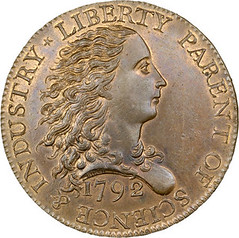 I
propose the Partrick 1792 Challenge. Heritage will be selling the Donald G. Partrick 1792 patterns during their FUN auction beginning January 7,
2015. The twelve coins are lots 5501 through 5512.
I
propose the Partrick 1792 Challenge. Heritage will be selling the Donald G. Partrick 1792 patterns during their FUN auction beginning January 7,
2015. The twelve coins are lots 5501 through 5512.
I intend to predict what each of the lots will realize at the sale. I propose to send my predictions to Wayne prior to the sale. I invite anyone else to also submit their estimates to Wayne. Let's go with hammer price to keep it somewhat more simple.
I propose that Wayne will judge the contest entries two ways. First, who will come closest to the actual total for the 12 lots. Second, Wayne will compute the variance for each lot. Thus estimates that are $10,000 over on one lot and $10,000 under on another lot may have the correct total but would have a variance of $20,000 for the two lots.
I propose that Wayne accept entries submitted up to Midnight on January 6, 1792. Wayne may establish other rules as he chooses. I suggest that he mentions the three best entries but does not mention names below the top three.

ON SIDEROGRAPHIC BANK NOTE PRINTING
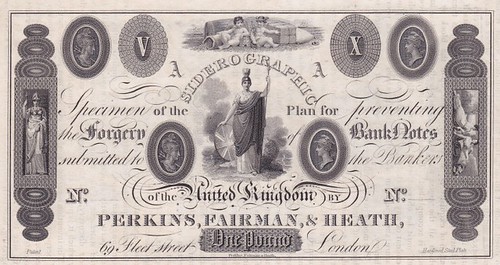
The term “siderographic” has been in use since the 1820s, according to this advertising note of Perkins, Fairman and Heath of London. A similar note is in Stack’s-Bowers 2015 New York International Numismatic Convention sale, lot 2102. Also see lot 2095 in that sale, a brochure on Perkins and Fairman’s “patent siderographic plan” published in 1819.
What does the term “siderographic” mean? I was unable to locate a dictionary definition.
The Greek word sidiros means iron (the metal), per R. Scott Carlton’s International Encyclopædic Dictionary of Numismatics. The words siderographic, siderographer, siderography are probably derived from this Greek word. So the literal meaning must be something similar to “graphic arts of (or produced by means of) iron (or steel).” In his 2009 book The Feel of Steel, Mark Tomasko explains the term. Under the topic “transferring,” Tomasko says:
“The invention of the transfer process [from an intaglio vignette on a master die, to a relief impression of the vignette on a roller die, to an intaglio image on a printing plate] was a critical advance for bank note engraving. The process is known formally as siderography and was unique to the bank note engraving industry.”
Prior to leaving the United States for England, Jacob Perkins patented a stereotype steel plate for printing bank notes, and obtained a legislative monopoly in the Commonwealth of Massachusetts for the use of such plates in printing all bank notes of the $1, $2, $3 and $5 denominations. Perkins wrote this up in a brochure titled “Perkins’ Bank Bill Test; Consisting of Original Impressions from the Permanent Stereotype Steel Plates … “ (etc.)
On June 15, 1813, Perkins also patented a transfer press for making multiple copies of hand-engraved images onto steel printing plates by means of a roller die, per Greville and Dorothy Bathe’s 1943 biography of Perkins, published by the Historical Society of Pennsylvania. Shown is a drawing of this transfer press and roller die taken from a plate in Bathe.
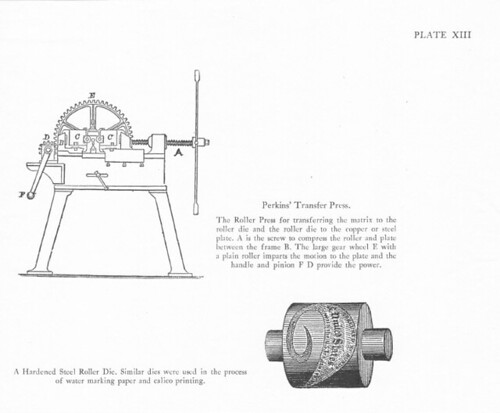
Perkins’s argument for the superiority of the steel plates was that it would achieve “a perfect uniformity in Bank Bills,” apparently the anticipated result of the improved durability of the steel plates when compared with the copper plates then in use. And with the bills’ designs being replicable among different banks by means of siderography, bills of many banks could be made uniform.
Interestingly, the term “siderographer” did not catch on with the artisans themselves. Their trade union was named the International Steel Plate Transferrers Association of America. Early in the 20th century they joined what is now the International Plate Printers, Die Stampers, Plate Makers and Engravers Union of North America, whose attractive souvenir convention booklets of engravings have become quite collectible.
THE BOOK BAZARRE
QUERY: WHERE DID THE U.S. MINT GET ALUMINUM?
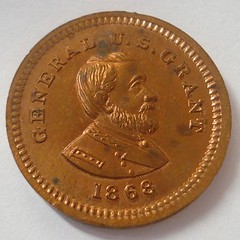
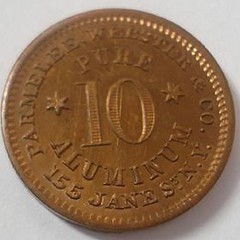
Because I collect aluminum type coins of the world, pre-1900 aluminum medals and medals relating to the aluminum industry, I purchased Kevin Flynn's recent book, "Experiments in Aluminum Coinage", to check on the earliest American coins struck in aluminum. All of them, of course, are patterns. The earliest coin listed by Flynn is an 1855 half dollar struck with regular dies for that coin, but with a plain edge. Listed as Judd 175 (Pollock 202), the only known example of this coin is held by Princeton University. The earlier catalog of United States pattern coins by Adams and Woodin (1913), lists an 1851 small size one cent coin with seated liberty design struck in aluminum and also in other metals. For some reason, Judd lists these coins under 1854 but says he can find no record of one struck in aluminum. I am sure that the 1851 one cent (if it exists) and the 1855 half dollar were not struck in the 1850's.
There was simply not enough aluminum in the world at that time for the U.S. mint to be making patterns in aluminum. However, beginning in 1863 the U. S. mint began a long flirtation with aluminum, using the metal to produce many trial strikes with regular dies and many patterns. Almost every year from 1863 through 1885 such coins were struck, about a hundred different pieces all together. After 1885, as the metal became cheap, the mint lost interest. The next aluminum coin was an 1890 Indian cent struck from regular dies and then in 1896, pattern one and five cent coins. Afterwards, no U.S. coins were struck in aluminum at the U.S. mints until 1974.
While looking into this subject, a lot on Ebay caught my eye -- a ten cent token from Parmelee, Webster & Company of New York City dated 1868 and inscribed "Pure Aluminum". The ebay lot (370935912076), however, was clearly struck in copper. The token, which has a nice portrait of General U. S. Grant on the obverse, is part of a set listed by the late Russ Rulau as NY243, which is known struck in silver, copper, brass, nickel, tin and aluminum. This token is most commonly seen in silver and copper; the aluminum piece seems to be the rarest. This piece, which may actually be a medal advertising the company, is one of the earliest aluminum numismatic items made in America. While researching the company, I found the following online (from the Annual Report of the American Institute of the City of New York for 1869):
"Dr. Dubois D. Parmelee exhibited some medals struck from pure aluminum manufactured by Parmelee, Webster & Co. at Hunters Point, Long Island. Dr. Parmelee stated that he had only a few weeks since made the first pound of aluminum reduced in America, and had recently cast a single bar weighing five pounds, which is now at the U. S. Mint at Philadelphia for the purpose of experimenting on coinage."
This suggests that the "medals" may have been the Parmelee, Webster & Co. "tokens" and that this company was the first in America to make a significant amount of aluminum. If this is true, then where did the U. S. Mint obtain the aluminum it used in 1863 and the years following?
To read the complete eBay lot listing, see:
GENERAL GRANT MEDAL ~ PURE ALUMINUM PARMELEE WEBSTE (www.ebay.com/itm/370935912076)
NUMISMATICS AND CRYPTOGRAPHY
The Imitation Game is a new movie, released December 25, 2014, about the cryptanalysts at Bletchley Park. Keira Knightley plays the role of Joan Clarke. Joan Elisabeth Lowther Murray (nee Clarke) was a brilliant mathematician, and an accomplished code-breaker.
Clarke was also a numismatist. The British Numismatic Society granted her a Sanford Saltus Gold Medal in 1986. By then she was married; and to the BNS, she was Joan E. L. Murray. You can find a brief biography in Wikipedia, of course, but as Joan Clarke. Lord Stewartby (Bernard Harold Ian Halley Stewart), one of her collaborators in the coinage of Scotland, wrote the obituary for the British Numismatic Journal Vol. 67 No. 13, pg 162-167) That essay provides a bibliography, including papers she read but did not publish. It also closes with a brief report by her, “Dating the End of the Robert Profile Groats.”
Her husband, Lieutenant-Colonel John Kenneth Ronald (Jock) Murray, who also worked at the Government Communications Headquarters, introduced her to the problems attendant in sequencing the gold unicorns and heavy groats of the kings James III and James IV of Scotland. Joan E. L. Murray stands out among Saltus awardees for having done all of her work in the area of Scottish numismatics.
The intersection of numismatics and cryptography may be a rich field. We know that Masonic Pennies present cryptic messages. (I suggest that the earliest known coins, lumps of electrum with a simple punch could also have been created as gate passes to secret meetings.) Coins with secret compartments are well known to us; and they are associated with spies and smugglers. Since the invention of the Alberti cipher disk in 1467, the “decoder ring” has been a collectible.
Sometimes collectors of cryptographic memorabilia call them “cipher coins.” They continue today because they are popular with geocachers. Geocaching is a treasure hunting game that includes both tracking via GPS coordinates and the unraveling of secret messages at each stop. (For one provider of ornate versions of the classic cipher disk, see TheCachingPlace.com.) The museum shop of the National Security Agency has sold replicas of the Confederate cipher disk of the War Between the States.
Computer security professionals have taken up the military challenge coin; and included codes ciphers and hidden messages in them.
The SANS Institute (www.sans.org) delivers computer security training. An important feature of computer security is penetration testing (“pen testing” for short). At conventions, workshops, and club meetings, computer security enthusiasts often have “capture the flag” challenges in which hackers attack a computer that is defended by a knowledgeable team. Some SANS Institute trainers have created challenge coins as awards and rewards.
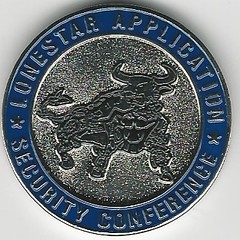

Successful students are called “forensicators”. “The Coin, Round Metal Object (RMO), is designed to be awarded to those who demonstrate exceptional talent, contributions, or helps to lead in the digital forensics profession and community. The Coin is meant to be an honor to receive it; it is also intended to be rare. Those who join the Lethal Forensicators Unit will have all privileges and recognition.”
The coins quickly evolved into a set with embedded codes and ciphers. The superior student now must win each of the coins in turn and then solve the puzzle.
Earlier this year, my wife, Laurel, and I volunteered to work the Lone Star Application Security Conference (LASCON). Our convention badges were metal plaquettes on which were printed in thin disguise the first key to a puzzle. Each clue led to another. Laurel solved the challenge and won a coin.
To read the complete article, see:
British Numismatic Journal Vol. 67 No. 13
(www.britnumsoc.org/publications/Digital%20BNJ/pdfs/1997_BNJ_67_13.pdf)
To read the complete article, see:
SANS Lethal Forensicator Coin
(http://digital-forensics.sans.org/community/lethal-forensicator)
To read the complete article, see:
Coinage: The SANS Pen Testing Coins
Backstory (http://pen-testing.sans.org/blog/pen-testing/2013/03/24/coinage-the-sans-pen-testing-coins-backstory)

CHINESE FORGERS TARGET BIMETALLIC COINS
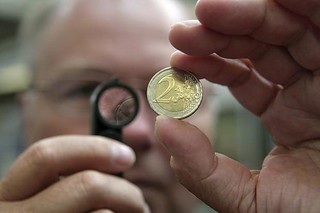 The
security of the £2 coin is under threat from a Chinese criminal gang which has mastered the intricate engineering techniques that lie behind its
manufacture.
The
security of the £2 coin is under threat from a Chinese criminal gang which has mastered the intricate engineering techniques that lie behind its
manufacture.
The Shanghai-based outfit has worked out how to produce near- perfect copies of bi-metallic coins — such as euros and the £2 piece — and has been flooding Europe with high-quality counterfeits.
In September, Italian police seized a shipment of fake euro coins with a face value of €500,000 hidden inside a consignment of metal pipes in the port of Naples.
The single seizure far outstripped the number of counterfeit coins seized across the European Union.
To read the complete article (subscription required), see:
Chinese forgers create ‘perfect’ £2 coins
(www.thetimes.co.uk/tto/news/uk/article4306100.ece)
GERMANS KEEP BILLIONS IN DEUTSCHMARKS
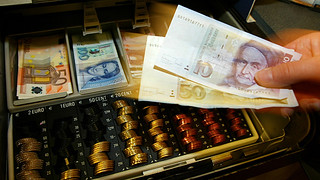 Despite the currency being replaced by the euro, Germans are still have some 12.9 billion in old
Deutschmarks, an equivalent of €6.6 billion, the German central bank estimated. Nostalgia is the primary motive for keeping the old coins and
notes.
Despite the currency being replaced by the euro, Germans are still have some 12.9 billion in old
Deutschmarks, an equivalent of €6.6 billion, the German central bank estimated. Nostalgia is the primary motive for keeping the old coins and
notes.
Germany abolished the Deutschmark in 2002, when it entered the Eurozone. When European currencies were unified the Bundesbank started changing marks into euros at a fixed rate of about DM 1.96 per euro and will continue to do so indefinitely.
But a large number of the obsolete banknotes and coins remain, if not in circulation then in possession of the general populace, the bank reported this week. Its estimates say Germans hold 169 million notes and 24 billion coins of various denominations. Divided by Germany’s population of 81 million, this translates into an average of 82 euros per person.
Naturally, less-valuable coins are the Deutschmarks the Germans are reluctant to part with. More than half of those had not been converted, while only four percent of banknotes were returned to the Bundesbank.
Old stashes of hoarded marks are being regularly discovered during renovations of old houses. They fuel a small but steady flow of annual Deutschmark conversions, which amounted to €52.1 million in 2014.
Nostalgia seems to be the most prominent motive for keeping good old D-marks. According to a poll conducted by the Emnid institute for Postbank, 74 percent of Germans with Deutschmarks in their pocket see a sentimental value in them. Some 24 percent keep part of their savings in the old currency, while 22 percent simply forgot to convert their assets, the poll showed.
To read the complete article, see:
Germans hoard €6.6 billion worth of obsolete Deutschmarks
(http://rt.com/news/217663-germans-keep-billions-deutschmarks/)

CHINESE COUNTERFEITERS COULD ATTACK THE TWO POUND COIN
The £2 coin could come under attack by Chinese forgers, it has been warned.
The coins which are bi-metallic, containing gold and silver components, were thought to be more difficult to forge than simpler designs such as the £1 coin.
But now a major seizure of €500,000 of euro coins has raised fears that Britain's £2 - with it's relatively higher value - could be in the forger's sights.
Italian detectives stumbled across the treasure trove of contraband currency while inspecting a consignment of metal pipes in the port of Naples.
The quality of the coins suggested that the gang is producing imitations of such high quality that they would even be accepted in vending machines, potentially costing businesses thousands in lost revenue.
A spokesman for the Royal Mint stressed that forgeries of £2 coins are not yet though to be commonplace.
"A bi-colour coin is much harder to counterfeit because replicating the two metal components, the inner and outer, is significantly more difficult than a single component coin. Forgers would also require a highly sophisticated press to produce bi-colour coins," said the spokesman.
"The coin detector mechanism of vending machines and self-service check-outs can detect the two different metal components, in addition to the conductivity, thickness and diameter of the coin."
"The addition of edge lettering is also very hard to counterfeit, and some circulating £2 coin designs also include a latent feature in their elements which is difficult to replicate."
To read the complete article, see:
Fears Chinese forgers could
perfect knock-off £2 coin (www.telegraph.co.uk/news/uknews/crime/11312103/Fears-Chinese-forgers-could-perfect-knock-off-2-coin.html)
U.S. RECYCLES OVER 90% OF DISCARDED BANKNOTES
Money may not grow on trees, but the Federal Reserve is helping grow trees out of money.
The Fed destroys more than 5,000 tons of U.S. currency a year—billions of dollars in torn, dirty or worn-out bills that are withdrawn from circulation and shredded. Most of it once went to landfills, but the central bank has pushed for years to go green with all that green.
It’s now succeeding in bringing the dollar out of the dump, recycling more than 90% of its discarded bills. Power plants burn them for fuel. Compost piles turn them into fertilizer. Some of them even end up in manufactured goods.
United Fibers LLC is one of many destinations, receiving three shipments of shredded cash a month at its factory in Chandler, Ariz. Old money, it turns out, is good for making cellulose insulation for houses, said Larry Williams, marketing and sales director for the company, which mostly relies on re-cycled newspapers and other paper products for raw material.
It’s also been good for marketing. “When you tell people you’re actually insulating their house with shredded money, it’s a great selling point for us,” Mr. Williams said.
The Fed gets most of its attention for high-level discussions about the economy and its decisions to adjust interest rates. But the flip side of monetary policy is the central bank’s mundane tasks of ordering money from the Treasury Department’s Bureau of Engraving and Printing, distributing freshly printed bills to banks around the country, and replacing them when they’re limp and worn out. Dollar bills are made from a mixture of cotton and linen for durability, but they wear out eventually. The $5 bill, for example, has an estimated lifespan of just under five years, according to the Fed.
Government officials used to destroy unfit currency by setting it on fire; the Federal Reserve Bank of Richmond’s 1953 annual report boasted it had “money to burn.” Today, shredders ensure the money taken out of circulation stays out of circulation. A little shredded cash goes into souvenir bags for visitors to regional Fed banks or the bureau’s printing plants in Washington and Fort Worth, Texas. But despite efforts over the years to find new uses for old money, most of it ended up being sent to landfills. Before 2010, only about 30% of shredded cash was being recycled, said Jim Narron, product man-ager at the National Cash Prod-uct Office at the Federal Re-serve Bank of San Francisco.
But times were changing. In 2011, the Fed began a push to increase recycling, asking officials across its 12 regional banks to seek local vendors that could reuse the material without any additional costs to the system.
The system was “looking for ways to be more green, more environmentally friendly, which is something we’re definitely interested in,” said Jake Lofton, an official in the Federal Reserve Bank of Philadelphia’s cash office.
The Philadelphia Fed in 2011 began sending its shredded cash to a local power plant. “Rather than just sitting in a landfill, it’s producing electricity for residents in the Delaware Valley, here in our district,” Mr. Lofton said.
For others, though, even destroyed money has a certain appeal. The Treasury signs off on a few dozen requests a year from people looking to use it for commercial or artistic purposes.
The agency in recent years has approved among other proposals, using cash to fill luxury dog beds, to manufacture knife handles and to “fashion into a brick for novelty purposes,” according to letters sent by the agency.
To read the complete article (subscription required), see:
Fed Scores in Bid to Keep Cash From Trash
(http://online.wsj.com/articles/fed-scores-in-bid-to-keep-cash-from-trash-1419294909)
To read the earlier E-Sylum article, see:
CHINESE CITY BURNS MONEY FOR POWER (www.coinbooks.org/esylum_v17n51a23.html)
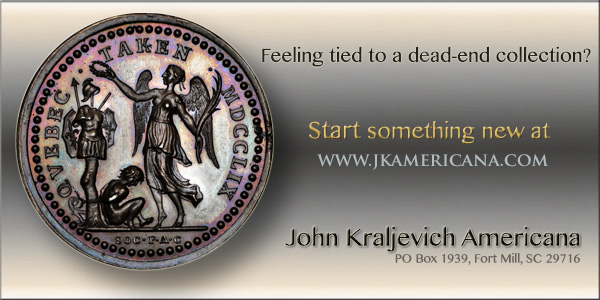
MCFADDEN COLLECTION OF PHILIPPINE EXONUMIA
Victory at Jolo gold Medal


Victory at Jolo gold Medal 1876 UNC (Hairlines), 23.5mm, Honeycutt-17, Basso-705. Very rare in gold, this Manila Mint issue possesses superb eye appeal despite light hairlines. Estimate: $1,500 - $2,500
To read the complete lot description, see:
http://coins.ha.com/itm/philippines/world-coins/
philippines-victory-at-jolo-gold-medal-1876-unc-hairlines-/a/241449-61003.s
Alfonso XIII copper Manila Railroad Medal
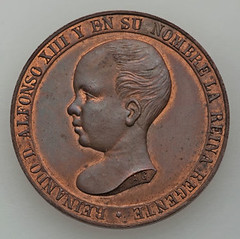
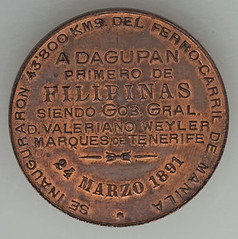
Alfonso XIII copper Manila Railroad Medal 1891 AU/UNC, 36mm, Honeycutt-34a, Basso-713a. A beautifully-preserved example with substantial remaining mint red. Estimate: $100 - $200.
To read the complete lot description, see:
http://coins.ha.com/itm/philippines/world-coins/philippines
-alfonso-xiii-copper-manila-railroad-medal-1891-au-unc-/a/241449-61015.s
Japanese Quartermaster Corps bronze Medal
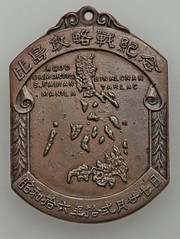

Japanese Quartermaster Corps bronze Medal 1941 VF, 30 X 38mm, Honeycutt - 317a, Basso- 155a. Obv. Map of the Philippines, "Commemorating the Conquest of the Philippines -December 27, 16th Year of Showa." Rev. "Great East Asia War-Watari 8857 Unit." By C. Zamora. Very scarce. Estimate: $200 - $250.
To read the complete lot description, see:
http://coins.ha.com/itm/philippines/world-coins/philippines
-japanese-quartermaster-corps-bronze-medal-1941-vf-/a/241449-61109.s
Surrender of Bataan and Corregidor Medal
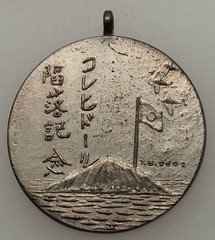
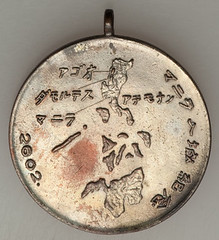
Surrender of Bataan and Corregidor Plated Bronze Medal 1942 VF, 32mm, Honeycutt - 320 var, Basso- 161 var. Obv. War planes over island. Rev. Map of Bataan and Corregidor. Very scarce. Estimate: $200 - $300.
To read the complete lot description, see:
http://coins.ha.com/itm/philippines/world-coins/philippines
-surrender-of-bataan-and-corregidor-plated-bronze-medal-1942-vf-/a/241449-61113.s
To view the complete auction, see:
http://click.ems.ha.com/?qs=7f8a55970adc1bb9fc3668aba320fb80b7fbf8de
31132ca12cc9b96bd63f5991d4619a6c9b69c234
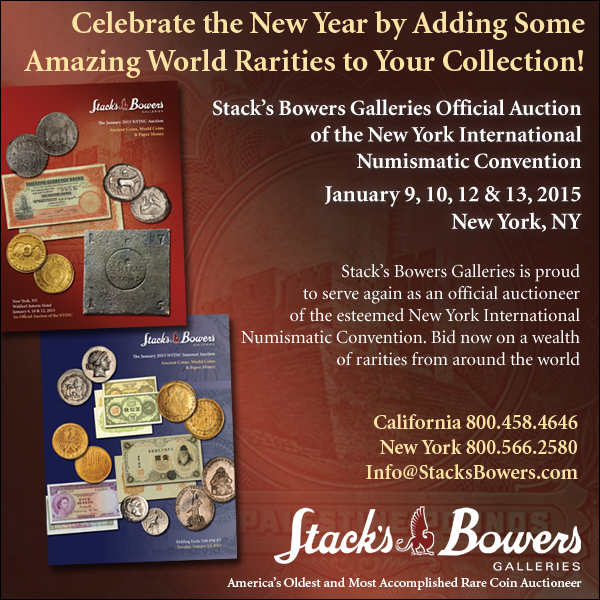
HOW BIG CAN NUMISMATIC ITEMS BE?
With the realization that the Pablo Picasso medallic item mentioned in the last two issues of The E-Sylum is 16 1/2 inches (42cm) the question becomes --- Is this numismatic? Would you consider this is too large to be placed within the realm of numismatics?
This discussion is not for the collector of coins whose specimens are all silver-dollar size or smaller. I have often heard this statement from such collectors: "If it doesn't fit in a 2x2 the hell with it!"
There is a larger world out there in an upper echelon of numismatics. Those coin collectors are missing a wide variety of the pleasures of the field in specimens which don't fit in a 2x2.
But it brings up the question: What is the range of sizes of collectible items which could be considered "numismatic"?
We know the smallest coin, at least struck in America, is the "Panama Pill" the 2 1/2 centesimos with a diameter of 10mm. But what is the top end of the numismatic spectrum?
The winner, hands down, is the 10-daler Swedish plate money. James Mackey lists a number of large coins in his book, "Coin Facts & Feats," starting with Swedish plate money and also listing the largest gold coin, the largest silver coin.
The E-Sylum carried an article in 2010 about large gold coins from Russia and China. But these were eclipsed by a $1 million dollar gold coin made in Canada the size of an auto wheel.
While these were made as dramatic stunts, perhaps, let's consider what can be acquired by an average collector.
Consider galvano reliefs. These are made from the sculptor's original patterns for both coins and medals. Coin models are generally less than ten inches (to be easily reduced to coin size dies).
Models for medals have been made up to 16-inch diameter (as some of the Society of Medallists series). It does not matter what size the artists makes these models, whatever he is comfortable in creating. They are reduced when cutting the die to desired size. Formerly this reduction was accomplished on the Janvier die-cutting pantograph, more recently by computer controlled engraving.
Often those original relief patterns were made into galvanos -- or foundry casts -- of the same size. Many of these have passed into collectors' hands, frequently offered in auctions of Presidential Art and other auction houses. They prove popular among collectors, despite the fact they don't fit in a coin cabinet and are destined to be hung on a wall.
Certainly then, the 16 1/2-inch Picasso relief mentioned above would obviously be considered "numismatic" since it falls in the category of a "medallic object."
So where is the boundary line for what is numismatic? For my databank I have arbitrarily chosen 18 inches as the top size. Anything smaller could be collected by an individual. Anything larger would more than likely be in the collections of institutions.
What is your opinion?
To read the earlier E-Sylum articles, see:
LOREN GATCH ON BIG GOLD COINS (www.coinbooks.org/esylum_v13n26a20.html)
MORE ON THE PABLO PICASSO SILVER AND GOLD MEDALS
(www.coinbooks.org/esylum_v17n52a12.html)
THE OHIO BOOK STORE
Jeff Starck of Coin World writes:
I couldn't help but notice the reference in this story to coin collecting books being among the books that Ohio Bookstore in Cincinnati is rebinding. E-Sylum readers may want to check this place out when in town. It is huge!
 Independently owned bookstores are like great-grandparents: You’re happy they’re still around, even if you’re not quite sure how they do it. And
while we can’t speak on behalf of thriving senior citizens, we do know why the Ohio Book Store has managed to establish itself as a Cincinnati
staple: Good books, great people, and exceptional bookbinding.
Independently owned bookstores are like great-grandparents: You’re happy they’re still around, even if you’re not quite sure how they do it. And
while we can’t speak on behalf of thriving senior citizens, we do know why the Ohio Book Store has managed to establish itself as a Cincinnati
staple: Good books, great people, and exceptional bookbinding.
Yes, bookbinding—and book repair. Owned and operated by Jim Fallon and his two sons, Jim Jr. and Mike, the 74-year-old bookstore is home to around 325,000 new and used books and magazines and has specialized in the craft of bookbinding since the early 1980s. Although “bookbinder” sounds like it would’ve gone the way of the milkman and the travel agent by now, the Fallon family is busier than ever.
“Right now we’re backed up several months with orders from all over the country. We’ve been fortunate to stay busy,” says the elder Jim Fallon.
Despite the fact that the store has four floors crammed floor-to-ceiling with books and magazines, it’s the basement—the entrance to which is located in the middle of the first floor—that caught our attention. Packed with centuries-old tomes and large, iron machines, it’s very tempting to describe it as a lair, but there simply aren’t enough steps, and it has fluorescent lighting. Still, this is where the magic happens.
It’s down here where the Fallons spend their days artfully restoring the bindings we’ve worn out and immersing themselves in the ways we’ve tried to keep our pages together. Whether it’s sheepskin, imitation leather, needle and thread, linen, or glue, each book brings a new story and a new challenge to the Fallons’ basement. Hence, there is no “one way” to bind a book. “It depends on the book. When it was made determines how it was originally bound, which determines how we’ll approach the rebinding process—that’s what makes it interesting,” Jim Jr. says.
The Ohio Book Store’s bindery knows few limitations. Its clients cross the country and range from individuals and collectors to libraries and museums. They send in family Bibles, photo albums, coin collecting books, more family Bibles, advertising pitches, and of course, nearly every type of book—in all states of disrepair and readiness for rebirth.
Sometimes, opening a book can change your life; other times, the binding breaks from sitting on a shelf far too long and it falls apart in your hands. Luckily, the Fallons can help you with both.
Ohio Book Store, 726 Main St., downtown, (513) 621-5142, ohiobookstore.net
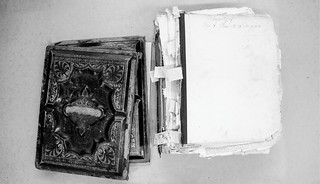 To read the complete article, see:
To read the complete article, see:
The Ohio Book Store’s Basement Business is
Booming www.cincinnatimagazine.com/citywiseblog/ohio-book-
stores-basement-business-booming/)
To read the complete do-it-yourself article, see:
How To: Restore An Old Book
(www.cincinnatimagazine.com/artsmindsblog/restore-old-book/)

Archives International Auctions, Part XXI
Hong Kong 4
Rare Chinese, Asian & Worldwide Banknotes, Coins and Scripophily.
Highlights include:
- Mercantile Bank of India, 1948 Specimen Banknote Rarity
- Deutsch-Asiatische Bank, 1907 "Peking Branch" Issue Banknote
- China, 1932, $1, L & M-108 Y-344, Birds Over Junk
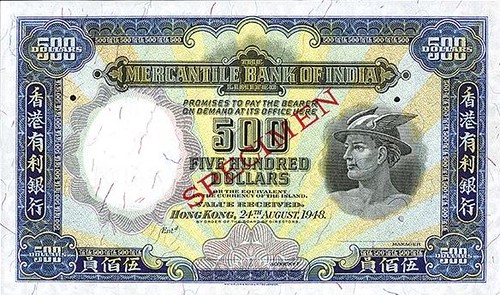
1580 Lemoine Avenue, Suite #7
Fort Lee, NJ 07024
Phone: 201-944-4800
Email: info@archivesinternational.com
WWW.ARCHIVESINTERNATIONAL.COM
METAL DETECTING AND THE PORTABLE ANTIQUITIES SCHEME
 Tens of thousands
of Britons from all walks of life, including a former member of the Rolling Stones, are regularly spending hours of their weekends searching for
hidden treasure and they have uncovered more than a million historic artefacts over the past 20 years, including hundreds of ancient Roman coin
hoards, elaborate Anglo-Saxon wargear and Viking silver.
Tens of thousands
of Britons from all walks of life, including a former member of the Rolling Stones, are regularly spending hours of their weekends searching for
hidden treasure and they have uncovered more than a million historic artefacts over the past 20 years, including hundreds of ancient Roman coin
hoards, elaborate Anglo-Saxon wargear and Viking silver.
Metal detecting is still condemned as near-vandalism by some archaeologists. However, the broadcast this autumn of BBC Four’s comedy series, Detectorists, has increased awareness of a hobby that has become much more accessible as a result of the equipment becoming cheaper.
With a £200 metal detector and some patience you are almost certain to find historical artefacts, and there is the chance that some will be valuable. However, for every knockout gold coin they find, experienced detectorists unearth hundreds of fascinating but low-value items such as worn bronze coins, buckles and buttons. Besides Mackenzie Crook, the author and co-star of Detectorists, another celebrity who is a metal detector enthusiast is Bill Wyman, the former Rolling Stones bassist, who now sells his own Wyman Signature Detector. He has found hundreds of artefacts, including medieval gold coins worth £1,000 each, but stresses that his hobby is for historical interest, not money.
Wyman has said: “After I’ve been out metal detecting I come home with my pockets full, wash the finds, spread them out to dry and begin to wonder what they all are. Then I can invent my own stories about how a particular coin or brooch came to be in that field. Detecting makes history so much more interesting — it’s a great hobby.”
The millionth find was recorded this year by the Portable Antiquities Scheme, a government initiative that began in 1997 and which encourages metal detectorists and other members of the public to report finds dating from before 1650 to local liaison officers for identification. The finds are mapped so archaeologists and other researchers can analyse their distribution and draw important conclusions about our history. The scheme is optional, but if your discovery could qualify as treasure, you have a legal obligation to report it to the district coroner.
The term “treasure” applies to any gold or silver artefact or group of coins more than 300 years old. If your find is declared treasure, you may be allowed to keep it, or there is the chance that it will be purchased by an institution; however, you should receive its full market value.
Since the scheme’s inception, detectorists have reported more than 500 discoveries of Roman coin hoards alone, including the Frome hoard of more than 52,000 coins found in a large ceramic pot in a field in Somerset. The hoard was acquired by the Museum of Somerset for £320,250 with the proceeds split between David Crisp, the finder, and the landowner.
Through coin finds, the scheme has already revealed the existence of previously unknown rulers, including Anarevito, a chieftain in Kent around the time of the birth of Christ. A silver-gilt badge depicting Richard III’s emblem of a white boar and probably worn by one of his retainers helped pin down the real site of the Battle of Bosworth.
Neil MacGregor, the director of the British Museum, says: “The success of the scheme and its site, finds.org.uk, cannot be overestimated in terms of our understanding of our past. The sheer variety and diversity of finds registered over its 17-year history is extraordinary and the one-millionth find is a truly exciting milestone.” The best way to get started in detecting is to attend a local club event. Clubs provide opportunities for prospective detectorists to meet members who can advise on getting started. You can find contact details for clubs at the website of the National Council for Metal Detecting.
To read the complete article, see:
For history and riches
go treasure-seeking (www.thetimes.co.uk/tto/money/consumeraffairs/article4306502.ece)
THE BOOK BAZARRE
MORE TABLETOP PENNY ART
Ralf Böpple writes:
There have been examples of the use of pennies in arts and handicraft in the newsletter, but I haven't seen this one yet
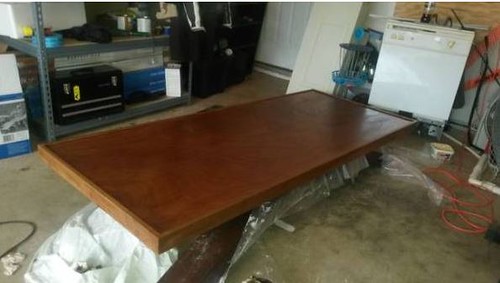

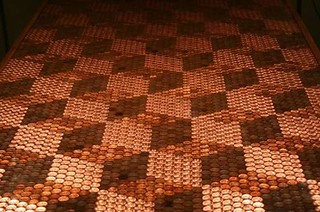
To read the complete article, see:
What One Guy Did With His Saved Up Pennies Is
Absolutely Brilliant (http://upyourday2.com/what-one-guy-did-with-his-saved-up-pennies-is-absolutely-brilliant-1)
CHRISTMAS LIGHT BONUS: CHINESE BANKNOTES
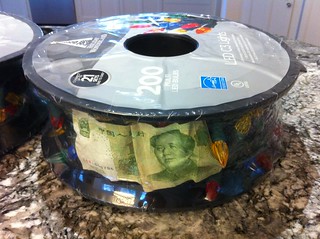
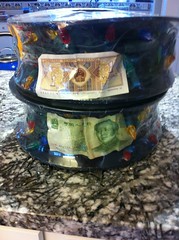
I bought four new rolls of Christmas lights at Kalamazoo's finest hardware shop, Gale's True Value, just before Thanksgiving. Two of these rolls (manufactured, of course, in China) included specimens of Chinese paper money.
This unusual find was shunted aside by the holiday rush, until I saw Issue 4 of ANS Magazine, which contains a report from Elena Stolyarik on new acquisitions at the ANS. Figure 17 (p. 65) depicts both sides of a 50-Yuan banknote, Series 1999 (from the fifth issue of renminbi). My found note is 1 Yuan, series of 1999.
Figure 19 (p.66) depicts both sides of a 5-Jiao banknote, Series 1980 (from the fourth series of renimbi). My found note is a 1-Jiao banknote, Series 1980.
Kudos to Mark Tomasko for donating these sets of bills to the ANS. Kudos, as well, to the anonymous workers who slipped my two bills under the plastic wrapping of these two rolls of lights. Was it done as a political statement? By mistake? I don't know. It was nice, however, to get a little numismatic dividend along with my new Christmas lights!
FEATURED WEB PAGE: THE E-SYLUM ARCHIVE
This week's Featured Web Page is the E-Sylum archive, home of all 18,000+ E-Sylum articles published to date.
http://www.coinbooks.org/club_nbs_esylum.html

